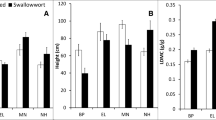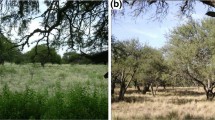Abstract
Centaurea stoebe L. subsp. micranthos is native to Eurasia and is invasive in the western portion of the US. Negative impacts of C. stoebe micranthos present in the eastern US have not been recorded. In this study, we examine the effects of C. stoebe micranthos on species diversity on an eastern grassy bald, compare the competitive abilities of plant species from eastern and western grasslands against C. stoebe micranthos, and assess the production of allelopathic compounds in an eastern population of C. stoebe micranthos. Field observations indicated that increasing C. stoebe micranthos abundance was not associated with decreasing abundance or diversity of species. In a greenhouse experiment, C. stoebe micranthos growing with plant species from an eastern grassland were smaller than C. stoebe micranthos growing with species from western grasslands, suggesting that species from the eastern grassland are more competitive against C. stoebe micranthos. We found no evidence that the eastern population of C. stoebe micranthos has allelopathic effects. While the invasion dynamics may change over time, the possibility that C. stoebe micranthos may never become invasive in the studied grassy bald should be weighed when considering control measures here and throughout the eastern US. This study illustrates that invasion dynamics can vary geographically and that land managers need relevant information to gauge an appropriate and economical response.



Similar content being viewed by others
References
Bais HP, Vepachedu R, Gilroy S, Callaway RM, Vivanco JM (2003) Allelopathy and exotic plant invasion: from molecules and genes to species interactions. Science 301:1377–1379 [Erratum post date 12 February 2010]
Bais HP, Weir TL, Perry LG, Gilroy S, Vivanco JM (2006) The role of root exudates in rhizosphere interactions with plants and other organisms. Annu Rev Plant Biol 57:233–266 [see Weir et al. 2010 Addendum]
Blair AC, Hanson BD, Brunk GR, Marrs RA, Westra P, Nissen SJ, Hubauer RA (2005) New techniques and findings in the study of a candidate allelochemical implicated in invasive success. Ecol Lett 8:1039–1047
Blair AC, Weston LA, Nissen SJ, Brunk GR, Hufbauer RA (2009) The importance of analytical techniques in allelopathy studies with the reported allelochemical catechin as an example. Biol Invasions 11:325–332
Callaway RM, Ridenour WM, Laboski T, Weir T, Vivanco JM (2005) Natural selection for resistance to the allelopathic effects of invasive plants. J Ecol 93:576–583
Christensen NL (1976) Short-term effects of mowing and burning on soil nutrients in Big Meadows, Shenandoah National Park. J Range Manag 29:508–509
Crone EE, Marler M, Pearson DE (2009) Non-target effects of broadleaf herbicide on a native perennial forb: a demographic framework for assessing and minimizing impacts. J Appl Ecol 46:673–682
Duke S, Blair A, Dayan F, Johnson R, Meepagala K, Cook D, Bajsa J (2009a) Is (−)-catechin a novel weapon of spotted knapweed (Centaurea stoebe)? J Chem Ecol 35:141–153
Duke SO, Dayan FE, Bajsa J, Meepagala KM, Hufbauer RA, Blair AC (2009b) The case against (−)-catechin involvement in allelopathy of Centaurea stoebe (spotted knapweed). Plant Signal Behav 4:422–424
Duncan CA, Jachetta JJ, Brown ML, Carrithers VF, Clark JK, DiTomaso JM, Lym RG, McDaniel KC, Renz MJ, Rice PM (2004) Assessing the economic, environmental, and societal losses from invasive plants on rangeland and wildlands. Weed Technol 18:1411–1416
Hall CN, Kuss FR (1989) Vegetation alteration along trails in Shenandoah National Park, Virginia. Biol Conserv 48:211–227
Inderjit, Pollock JL, Callaway RM, Holben W (2008) Phytotoxic effects of (±)-catechin in vitro, in soil, and in the field. PLoS One 3:e2536
Kowarik I (1995) Time lags in biological invasions with regard to the success and failure of alien species. In: Pysek P, Prach K, Rejmánek M, Wade M (eds) Plant Invasions, 1st edn. SPB Academic Publishing, Amsterdam, pp 15–38
Lau JA, Puliafico KP, Kopshever JA, Steltzer H, Jarvis EP, Schwarzländer M, Strauss SY, Hufbaur RA (2008) Inference of allelopathy is complicated by effects of activated carbon on plant growth. New Phytol 178:412–423
Maron JL, Marler M (2008) Field-based competitive impacts between invaders and natives at varying resource supply. J Ecol 96:1187–1197
Ortega YK, Pearson DE (2005) Weak vs. strong invaders of natural plant communities: assessing invasibility and impact. Ecol Appl 15:651–661
Ridenour WM, Callaway RM (2001) The relative importance of allelopathy in interference: the effects of an invasive weed on a native bunchgrass. Oecologia 126:444–450
Rinella MJ, Maxwell BD, Fay PK, Weaver T, Sheley RL (2009) Control effort exacerbates invasive-species problem. Ecol Appl 19:155–162
Schirman R (1981) Seed production and spring seedling establishment of diffuse and spotted knapweed. J Range Manag 34:45–47
Sheley RL, Jacobs JS, Carpinelli MF (1998) Distribution, biology, and management of diffuse knapweed (Centaurea diffusa) and spotted knapweed (Centaurea maculosa). Weed Technol 12:353–362
Simberloff D (2003) How much information on population biology is needed to manage introduced? Conserv Biol 17:83–92
Tharayil N, Triebwasser D (2010) Elucidation of a diurnal pattern of catechin exudation by Centaurea stoebe. J Chem Ecol 36:200–204
Thorpe AS, Thelen GC, Diaconu A, Callaway RM (2009) Root exudate is allelopathic in invaded community but not in native community: field evidence for the novel weapons hypothesis. J Ecol 97:641–645
Watson AK, Renney AJ (1974) The biology of Canadian weeds: 6. Centaurea diffusa and C. maculosa. Can J Plant Sci 54:687–701
Weigelt A, Steinlein T, Beyschlag W (2002) Does plant competition intensity rather depend on biomass or on species identity? Basic Appl Ecol 3:85–94
Weir TL, Perry LG, Gilroy S, Vivanco JM (2010) The role of root exudates in rhizosphere interactions with plants and other organisms: an addendum. Annu Rev Plant Biol [Addendum to: Bais et al. 2006]. http://www.annualreviews.org/doi/full/10.1146/annurev-plant-57-033010-200001
Acknowledgments
The research of K.O.R. was supported by National Parks Ecological Research Fellowship Program, funded through a grant from the Andrew W. Mellon Foundation helping form a partnership between the National Park Service, the Ecological Society of America and the National Park Foundation. We appreciate Melanie Knapp and Manuel Rodriguez IV for assistance with the greenhouse experiment and Erin Espeland and Jeremy James for comments on this manuscript.
Author information
Authors and Affiliations
Corresponding author
Rights and permissions
About this article
Cite this article
Reinhart, K.O., Rinella, M. Comparing susceptibility of eastern and western US grasslands to competition and allelopathy from spotted knapweed [Centaurea stoebe L. subsp. micranthos (Gugler) Hayek]. Plant Ecol 212, 821–828 (2011). https://doi.org/10.1007/s11258-010-9867-x
Received:
Accepted:
Published:
Issue Date:
DOI: https://doi.org/10.1007/s11258-010-9867-x




